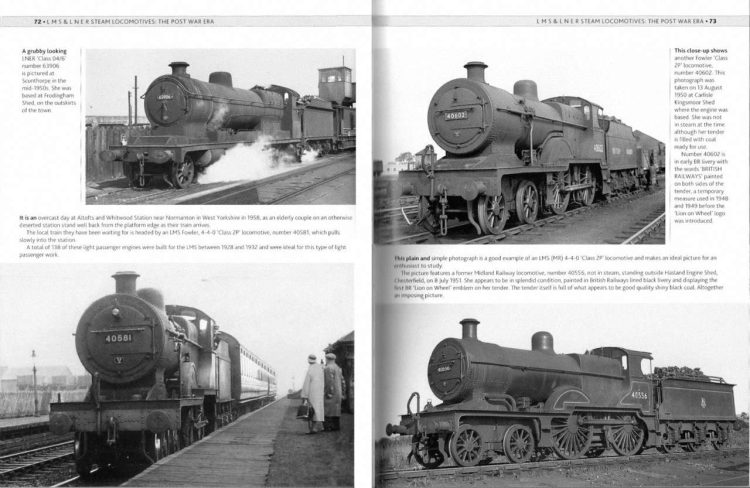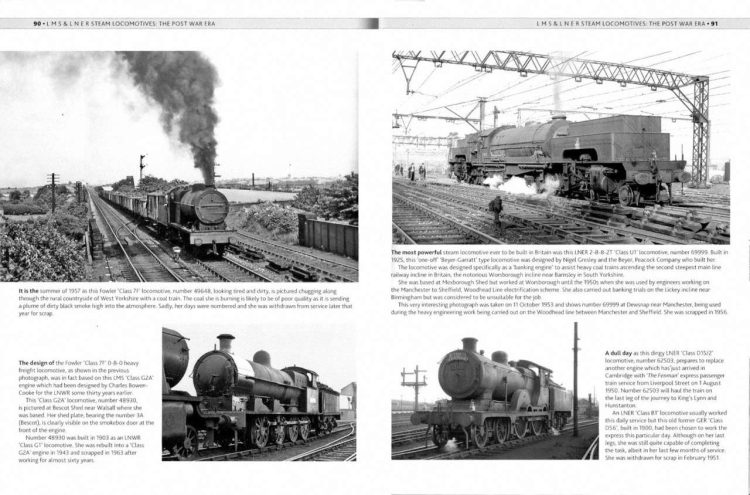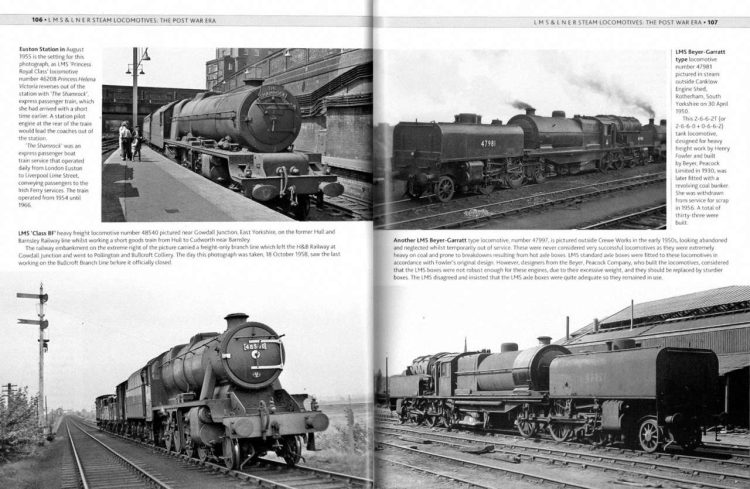Published in July 2021, this book from publishers Pen & Sword provides a selection of photographs of LMS and LNER locomotives after Nationalisation in 1948.
Written by Malcolm Clegg, this hardback book measures around 28.6 cm x 22.4 cm, is 168 pages long, and has 200 black and white illustrations. It has a published price of £25, and at the time of writing it can be obtained online from Pen & Sword for a 10% discount and from Amazon for around £18. The quality of the finished product is impeccable.
The book is profusely illustrated with each photograph accompanied by a well-written caption. Although Malcolm Clegg is credited as being the author, all photographs are from the private collection of the author’s lifelong friend, Peter Cookson, who also provided the detailed caption information. Peter is also a railway historian, author and amateur photographer.
The book is sub-titled the Post War Era, but the Introduction gives the history of railways from 1825 to 1948. There is just one photo between the end of the war and Nationalisation in 1948, whilst some of the photos are taken in the 1960s, so “After Nationalisation” would be a more suitable sub-title.
The photographs themselves are superbly reproduced with informative captions, but these sometimes refer to a locomotive’s colour, yet all the photos are black and white! The captions also contain technical information about the locomotives, but the same information is often a duplicate of what is in the Technical Details Section.
Railway enthusiasts tend to follow the railways of a certain era or group and so it is unusual for a book to look at two different railway companies in the same volume. This book should have offered a chance to compare similar locomotives of the two companies side by side, such as LMS Coronations and LNER A4 Pacifics, or LMS 8F 2-8-0s and LNER O1 and O4 2-8-0s, but with very few exceptions the layout of the book precludes this.
Unfortunately, there are many instances of an odd mixture of photos, with LMS compounds opposite an LNER V2 and A4 Pacific, LMS Coronation Pacifics opposite ex-Lancashire & Yorkshire 0-6-0s, LMS tank engines opposite Royal Scot class 4-6-0s, and LNER A3 Pacifics opposite LMS 4F 0-6-0s.
There are also notable omissions, including Stanier Class 3 2-6-2 tank engines, of which nearly 150 existed at Nationalisation, Ivatt Class 4MT 2-6-0s with 162, and LMS Class 3F 0-6-0s with 382. LNER classes missing include L1 2-6-4 tank engines, which for many years were workhorses on Kings Cross and Liverpol Street suburban services.
The pages below are an example of overkill, with three LMS Class 2P 4-4-0s shown with an LNER O4 2-8-0, whereas it would have been interesting to compare the Class 2Ps against Class 4P “Compounds”, of which there are seven shown elsewhere in the book.

It would have been nice to be able to compare the LNER’s Beyer-Garratt against those of the LMS, but sadly 15 pages separate the two types of loco as seen below.

Instead of being able to compare the LMS Beyer-Garratts against the LNER’s version, they are shown opposite an LMS Princess Royal Class Pacific.

The book is available to purchase from Amazon and from Pen & Sword.
In summary, this book comprehensively illustrates and describes locomotives of the former LMS and LNER from Nationalisation until the end of steam on British Railways. It will be welcomed by LMS, LNER and early British Railways enthusiasts alike as it offers a feast of high-quality photographs, many previously unpublished, with comprehensive captions and technical details of the subject locomotives. However, I question why the author has chosen to cover both LMS and LNER locomotives in the same volume. But having decided to go down that route, why weren’t similar locos from the two regions not shown on the same page. With those provisos it is highly recommended.
We would like to thank Pen & Sword for providing RailAdvent with a copy of the book for review.





Responses